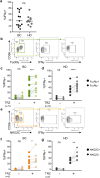Phenotypic and functional analysis in HER2+ targeted therapy of human NK cell subpopulation according to the expression of FcεRIγ and NKG2C in breast cancer patients
- PMID: 37081323
- PMCID: PMC10992268
- DOI: 10.1007/s00262-023-03448-w
Phenotypic and functional analysis in HER2+ targeted therapy of human NK cell subpopulation according to the expression of FcεRIγ and NKG2C in breast cancer patients
Abstract
Adaptive NK cells constitute an NK cell subpopulation, which expands after human cytomegalovirus (HCMV) infection. This subpopulation has stronger production of cytokines after CD16 stimulation, longer life and persistence than conventional NK cells and are, therefore, interesting tools for cancer immunotherapy. Since there is limited information on adaptive NK cells in cancer patients, we described this population phenotypically and functionally, by flow cytometry, in the context of HER2 + breast cancer (BC) directed therapy. We assessed HCMV status in 78 patients with BC. We found that, similarly to healthy donors (HD), a high proportion of BC patients were HCMV-positive, and nearly 72% of them had an adaptive NK cell subpopulation characterized by the loss of FcεRIγ intracellular adaptor protein or the presence of NKG2C receptor. However, in BC patients, FcεRIγ- and NKG2C + NK cell populations overlapped to a lesser extent than in HD. Otherwise, no profound phenotypic differences were found between BC patients and HD. Although FcεRIγ- or NKG2C + NK cell subsets from BC patients produced more IFN-γ than their FcεRIγ + or NKG2C- NK cell counterparts, IFN-γ production increased only when NK cells simultaneously expressed FcεRIγ- and NKG2C + , whereas in HD the presence of NKG2C marker was sufficient to display greater functionality. Furthermore, in a group of patients treated with chemotherapy and Trastuzumab plus Pertuzumab, FcεRIγ-NKG2C + and FcεRIγ-NKG2C- NK cells retained greater functionality after treatment than FcεRIγ + NKG2C- NK cells. These results suggest that the presence or magnitude of adaptive NK cell subsets might serve as a key determinant for therapeutic approaches based on antibodies directed against tumor antigens.
Keywords: ADCC; Adaptive NK cells; HER2 + breast cancer; Trastuzumab.
© 2023. The Author(s), under exclusive licence to Springer-Verlag GmbH Germany, part of Springer Nature.
Conflict of interest statement
The authors have no relevant financial or non-financial interests to disclose.
Figures







References
MeSH terms
Substances
Grants and funding
LinkOut - more resources
Full Text Sources
Medical
Research Materials
Miscellaneous

